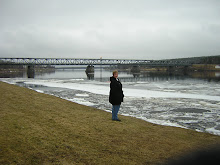At my friend Marion's request, here's my absolutely bitchin' recipe for chicken and dumplings. Well, not so much my recipe as Southern Living's, published in their 1981 Annual Recipes (yeah, I'm old). I could have taken a picture of this last night, since that's what we had for dinner, but I didn't. Next time. (Rich will be so disappointed to hear I need to make this again to take a picture. It might be his very favorite thing I cook. Honestly, it may be mine, too.)
Old Fashioned Chicken and Dumplings
Ingredients:3 cups all purpose flour
1 tablespoon baking powder
1 teaspoon salt
1 cup chicken broth
1/4 cup vegetable oil
3–4 quarts chicken broth
Cooked chicken, shredded
To cook:
Combine the flour, baking powder and salt. Add the chicken broth and vegetable oil; stir until the dry ingredients are moistened. Turn out onto a large, generously floured surface. Roll the dough to 1/16" thickness. Using a pizza cutter if you have one, or a knife if you don't, cut the dough into 5- x 1-inch strips.
Bring the broth to a full boil. Drop in the dumplings, one at a time. Cover, lower the heat so it won't boil over, and cook for 15 minutes. Stir in the chicken. Add salt and pepper to taste. Continue cooking, uncovered, until desired thickness is reached.
A few notes:
You really ought to use some of the broth to cook the chicken. Just add that broth to the pot with the rest of it after the chicken is done. I normally use a pressure cooker, but you can also stew or simmer it—your choice. I use 5 or 6 boneless, skinless thighs, but you can use whatever pieces you have handy and thawed. You just want to end up with a few cups (or whatever amount you like) of cooked chicken. I'd advise against adding vegetables when you cook the chicken, because it muddies up the flavors pretty quickly, but that's just my personal preference. And using the b/s thighs, I scrape off the visible fat first. After it's done, tear or shred into bite-size pieces (it's not as good if it's cubed).
I use a pastry cloth, i.e., a piece of canvas from my local fabric shop, to roll out the dough. You can also use a plastic or silicon sheet, or just a clean countertop, generously floured. Wherever you do it, make sure you've got a large area. Seriously, it takes a good-sized piece of counter real estate, maybe 2-1/2 feet square. And, yes, really, 1/16". The dumplings swell up as they cook, so if you start with them any thicker than that, you're going to end up with slabs. I like to take the dumplings off the pastry cloth after they're cut and layer them on a plate, sprinkling them frequently with flour so they won't stick together too much. That speeds up the process of dropping them in the boiling broth quite a bit.
If your schedule calls for it, or if you just prefer, after you mix the chicken in you can transfer the whole shebang to a slow cooker. Cook it on 'Low' until you're ready to eat. And, slow cooker or not, if it looks like it's not going to thicken up enough, mix a tablespoon or so of flour with cool broth or water, stir it in, and cook for a few more minutes.
This recipe is not only great comfort food, it's also perfectly suitable for delicate stomachs. No spices, nothing hard to digest…I used it to get over a case of Delhi Belly after returning from India, and fed it to Rich as he recovered from a terrible case of food poisoning a few years ago. An all-around good recipe to keep handy.
I think I'll go have some leftovers for lunch. Bon appetit, Marion!



